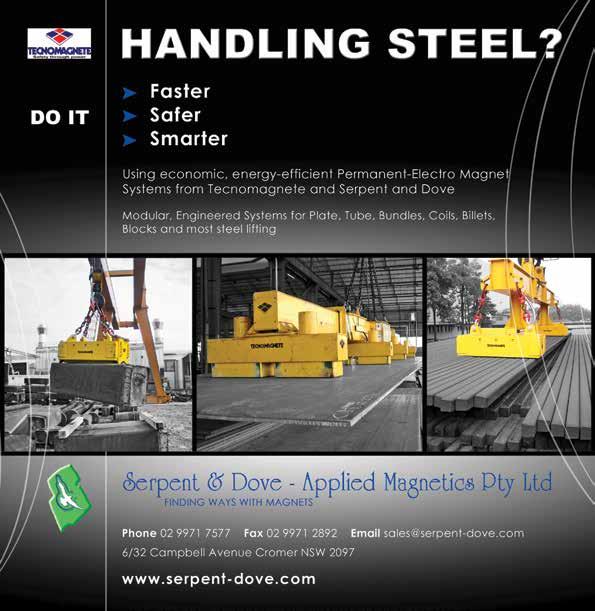INDUSTRY POLITICS THE HON. KAREN ANDREWS MP – PARLIAMENT OF AUSTRALIA, MINISTER FOR INDUSTRY, SCIENCE AND TECHNOLOGY
By pursing the philosophy of “what if” it has also changed the market, outpacing China on the manufacture of prescription glasses frames, producing them at a cheaper price than anywhere in the world.
USING SCIENCE AND TECHNOLOGY TO GROW AUSTRALIAN MANUFACTURING
We know there is much more that must be done to see more manufacturers realise their potential.
WiFi and GPS are so entwined in our lives. They have transformed the daily commute, our daily interactions and how businesses do business.
changing business conditions, it is now more important than ever for industry, and particularly our manufacturers, to wonder “what if”?
In 2020, they have helped families learn, live and work from home, getting food and supplies delivered to their doorsteps.
What if we were to change our materials?
Take, for example, NSW optical company Dresden. It worked in a market where glasses were costly, fragile and made from non-ecofriendly materials.
What if we were to switch up that process?
But they wondered what if they could do something different.
What if we were to collaborate with someone new?
Dresden made science and technology work for their vision, finding entirely new partners from the research and university sector alongside other manufacturers.
They have helped businesses go online and take their business direct to customers. These two now seemingly indispensable technologies were born by science and the one simple question that drives all innovation: “what if”? Science and technology have tremendous power to change our lives and to revolutionise industry.
As we look to chart our economic recovery now and for future generations, it is crucial we get science and technology working for industry – a key pillar of the Morrison government’s $1.5 billion Modern Manufacturing Strategy.
And with the seismic impacts of COVID-19 restrictions and their legacies, affecting supply chains, and fundamentally
The clever use of both science and technology can be a game changer for our manufacturers. It can improve productivity,
make them more competitive and it can create new jobs.
By pushing the envelope of the possible and utilising research, Dresden now manufactures glasses that are 100 per cent recyclable – transforming milk bottle tops, beer keg taps and discarded fishing nets among other items. But that’s not the end of the story.
THE HON. SENATOR ERIC ABETZ, A MEMBER OF THE POLITICAL ADVISORY BOARD OF CANZUK AND A FORMER LIBERAL MINISTER FOR EMPLOYMENT
CANZUK, CHINA, COVID-19 AND OUR MANUFACTURING FUTURE It is frequently (yet incorrectly) stated that the Chinese word for crisis is composed of two Chinese characters signifying "danger" and "opportunity". Recently, Chinese state media announced a halt on exports from Australia worth more than $6 billion a year that included wine, lobster, copper, sugar, timber and coal that arrived in China after November 6 2020. This announcement came after China placed tariffs on Australian barley and meat earlier in the year. Months before that, a virus spread from Wuhan across the globe and continues to devastate economies as they deal with its health implications. A few years before that, the UK decided to unshackle itself from the European Union and forge a new economic destiny. With these events, Australia is presented with the dangers of uncertainty but also with an opportunity to lay the foundations for Australia's manufacturing future. This once-thriving industry
16
INDUSTRYUPDATE.COM.AU
is still capable of producing quality goods for export and domestic markets. The events of 2020 can therefore be the catalyst for an overdue discussion on the future of Australia's manufacturing and how to reorganise it effectively as we face such severe challenges. Some view Australian manufacturing as a product of a bygone era, obsolete in the age of globalisation, ever-dwindling comparative advantages and a flood of cheap imported goods. Yet manufacturing employs some 860,000 Australian, and before COVID-19 it generated more than $100 billion in annual value to the Australian economy and over $50 billion in exports. It is more important than ever to keep producing goods in Australia. Manufacturing contributes around one-quarter of total research and development investment in Australia, roughly four times its share of the economy. It is particularly important to regional economies, and in my home state of Tasmania, 1,465 manufacturing businesses employ almost 15,000 people.
Last month the federal government announced a new era for Australian manufacturing with the $1.5 billion Modern Manufacturing Strategy to help rebuild the economy and recover from the COVID19-induced recession. The strategy will make Australian manufacturers more competitive, resilient and able to scale-up to take on the world while building upon our nation's self-sufficiency. It is an opportunity to grow into new and emerging local and global markets. With increasing global economic uncertainty, there lies the opportunity for Australia to increase its economic cooperation with nations it shares close cultural and historical ties, particularly Canada, New Zealand and the UK. In 2019-20, trade between CANZUK nations included: •
manufacturing exports to Canada totalling $512.6 million;
•
elaborately transformed manufactures
That is why our Modern Manufacturing Strategy, with the $1.3 billion Modern Manufacturing Initiative at its heart, is designed to supercharge our manufacturing businesses to lead us out of this pandemic We want to encourage our businesses to seize the opportunities to scale up, become more resilient and more competitive. We want to back our businesses to leverage their bright ideas and to collaborate with our world-class researchers and scientists. We want to encourage our businesses to invest in innovation – because by improving their processes and practices to be cuttingedge they can reinvent their products and take on the world – just like Dresden. For it is embracing science and technology and asking “what if” that will have people exclaiming in wonder, “how many?!” How many manufacturing jobs have you created? comprising over 90 per cent of exports to New Zealand with more than 51 per cent engineering products at $3,690.4 million; and •
exports to the UK that were elaborately transformed manufactures and comprised more than 67 per cent of exports, with 46 per cent engineering products at $867.4 million.
According to the DHL Export Barometer 2019 report, growth in export orders from New Zealand topped the list. Growth in export orders from the UK has steadied since 2016, reaching 35 per cent in 2019. The report goes onto highlight the potential of the CANZUK nations, stating: This year's results show a more significant number of small to medium-sized businesses entering the export market. For companies new to exporting, we typically see a trend where they concentrate their expansion in markets with familiar consumer buying preferences, cultures and languages. For Australian export businesses, these markets are likely to be other Western nations, such as New Zealand, the US or Canada. For Australia, there is a high level of uncertainty about the likely impacts of Brexit – with agreements still to be reached between the UK and the EU. Negotiations are continuing with an Australia – United Kingdom Free Trade Agreement and an Australia-European Union Free Trade Agreement. As Australia – and the world – faces a profoundly uncertain economic future, the nation's manufacturing sector can, with careful nurturing, overcome the problems of the past to be a solution for the COVID-19 economic recovery. NOVEMBER 2020






